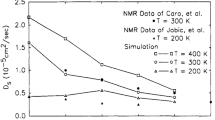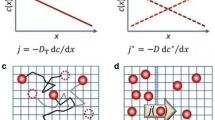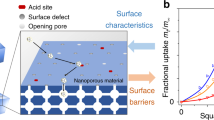Abstract
For anisotropic nanoporous materials, guest diffusion is often reflected by a diffusion tensor rather than a scalar diffusion coefficient. Moreover, the resulting diffusion anisotropy may notably differ for different guest molecules. As a particular class of such systems, we consider an array of two types of channels, mutually intersecting each other, where the rates of diffusion in the different directions depend on the nature of the guest molecules. The simultaneous adsorption of two types of guest molecules is considered, as in technical applications of porous materials such as catalysis. A case study is presented in which atomistic molecular dynamics (MD) and coarse-grained dynamic Monte Carlo (DMC) simulations are compared and shown to yield qualitatively similar results for non-steady-state diffusion. The two techniques are complementary. MD simulations are able to predict the details of molecular propagation over distances of a few unit cells, whereas the evolution of sorption profiles over distances comparable with entire crystallites can be studied with DMC simulations. Consideration of these longer length and time scales is necessary for applications of such systems in chemical separations and heterogeneous catalysis.
Similar content being viewed by others
References
Bräuer, P., J. Kärger, and N. Neugebauer, “Reaction and Particle Distribution in Networks of Single-file Systems,” Europhys. Lett., 53, 8–14 (2001).
Bräuer, P., A. Brzank, and J. Kärger, “Adsorption by Single-file Networks Under Molecular Traffic Control,” Appl. Surface Sci., 196, 273–280 (2002).
Bräuer, P., A. Brzank, and J. Kärger, “Adsorption and Reaction in Single-file Networks,” J. Phys. Chem. B, 107, 1821–1831 (2003).
Bräuer, P., A. Brzank, and J. Kärger, “Two-Component Desorption from Anisotropic Pore Networks,” J. Chem. Phys., 124, 034713 (2006).
Brzank, A., G.M. Schütz, P. Bräuer, and J. Kärger, “Molecular Traffic Control in Single-file Networks with Fast Catalysts,” Phys. Rev. E, 69, 31102 (2004).
Chen, N.Y, T.F. Degnan Jr., and C.M. Smith, Molecular Transport and Reaction in Zeolites, VCH, New York, 1994.
Clark, L.A., G.T. Ye, and R.Q. Snurr, “Molecular Traffic Control in a Nanoscale System,” Phys. Rev. Lett., 84, 2893–2896 (2000).
Conner, W.C. and J. Fraissard (Eds.), Fluid Transport in Nanoporous Materials, Springer, Dordrecht, 2006.
Derouane, E.G. and Z. Gabelica, “A Novel Effect of Shape Selectivity: Molecular Traffic Control in Zeolite ZSM-5,” J. Catal., 65, 486–489 (1980).
Hong, U., J. Kärger, H. Pfeifer, U. Müller, and K.K. Unger, “Observing Diffusion Anisotropy in Zeolites by Pulsed Field Gradient NMR,” Z. Phys. Chem., 173, 225–234 (1991).
June, R.L., A.T. Bell, and D.N. Theodorou, “Molecular Dynamics Study of Methane and Xenon in Silicalite,” J. Phys. Chem., 94, 8232–8240 (1990).
Kärger, J., P. Bräuer, and H. Pfeifer, “Reaction Rate Enhancement in Nanoporous Materials with Single-File Behaviour,” Z. Phys. Chem., 214, 1707–1722 (2000).
Kärger, J., F. Grinberg, and P. Heitjans (Eds.), Diffusion Fundamentals, Leipziger Universitätsverlag, Leipzig, 2005.
Kärger, J., and D.M. Ruthven, Diffusion in Zeolites and Other Microporous Solids, Wiley, New York, 1992.
Marsaglia, G., A. Zaman, and W.W. Tsang, “Toward a Universal Random Number Generator,” Statist. Prob. Lett., 9, 35–39 (1990).
Neugebauer, N., P. Bräuer, and J. Kärger, “Reactivity Enhancement by Molecular Traffic Control,” J. Catal., 194, 1–3 (2000).
Paschek, D. and R. Krishna, “Diffusion of Binary Mixtures in Zeolites: Kinetic Monte Carlo Versus Molecular Dynamics Simulations,” Langmuir, 17, 247–254 (2001).
Ruthven, D.M., Principles of Adsorption and Adsorption Processes, Wiley, New York, 1984.
Sherman, J.D., “Synthetic Zeolites and Other Microporous Oxide Molecular Sieves,” in Proceedings of the National Academy of Sciences of the U.S.A., 96, 3471 – 3478 (1999).
Snurr, R.Q., J.T. Hupp, and S.T. Nguyen, “Prospects for Nanoporous Metal-Organic Materials in Advanced Separations Processes,” AIChE J., 50, 1090–1095 (2004).
Snurr, R.Q. and J. Kärger, “Molecular Simulation and NMR Measurements of Binary Diffusion in Zeolites,” J. Phys. Chem. B, 101, 6469–6473 (1997).
Surfer (Win 32), Version 6. 04, Feb 24 1997, Surface Mapping System, Copyright (c) 1993-97, Golden Software, Inc.
Author information
Authors and Affiliations
Rights and permissions
About this article
Cite this article
Bräuer, P., Brzank, A., Clark, L.A. et al. Guest-specific diffusion anisotropy in nanoporous materials: Molecular dynamics and dynamic Monte Carlo simulations. Adsorption 12, 417–422 (2006). https://doi.org/10.1007/s10450-006-0569-6
Issue Date:
DOI: https://doi.org/10.1007/s10450-006-0569-6




